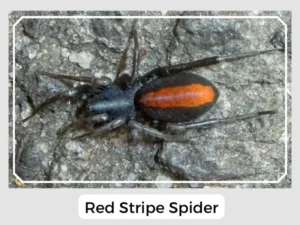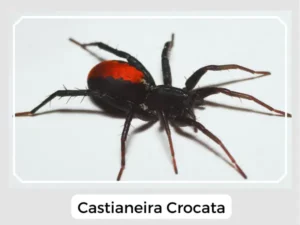Meet the red stripe spider! This little crawler is part of the Corinnidae spiders family and loves living in some areas of North America. We’ve gathered some fun facts about this striped wonder for you to explore.

Photo Credit: Seth Ausubel
The eggs are placed inside a white circular silken sac, generally attached to rocks.
They move about independently after hatching.
These spiders build webs close to their resting places.
Yes, Red Stripe spiders have venom. They use it to catch the little bugs they like to eat. For humans, this venom isn’t usually a worry.
They sure can! But Red Stripe spiders are often peaceful. They might give a little bite if they feel scared, but they mostly enjoy their spider activities.

Photo Credit: Bruce
The red stripe spider plays a pivotal role in the control of insect populations. Through their predatory behavior, they help maintain a balanced ecosystem. Active primarily at night, they showcase the intricate dynamics of nocturnal predation.
Natural Predators: Birds and wasps are among the primary natural adversaries of the red stripe spider. These interactions are crucial in controlling spider populations and contributing to the ecological equilibrium.
Prey-Predator Dynamics: As predators, red stripe spiders feed on common insects, which helps prevent potential insect overpopulation. This dynamic is essential for the health of our natural landscapes.
Relationship with Humans: Red stripe spiders are often unnoticed by humans due to their small size and peaceful nature. Their presence is a sign of a healthy environment, and they contribute to the control of pests.
| Lifespan | 1-3 years |
| Distribution | The United States |
| Habitat | Parks, shrubs, and woods |
| Common Predators | Birds, wasps, other spiders |
| Diet | Small insects like ants |
In conclusion, the red stripe spider, though small, plays a significant ecological role. Their presence in North American habitats is a testament to the diverse and interdependent web of life that thrives in our parks and woodlands.
Meet the red stripe spider! This little crawler is part of the Corinnidae spiders family and loves living in some areas of North America. We’ve gathered some fun facts about this striped wonder for you to explore.

Photo Credit: Seth Ausubel
The eggs are placed inside a white circular silken sac, generally attached to rocks.
They move about independently after hatching.
These spiders build webs close to their resting places.
Yes, Red Stripe spiders have venom. They use it to catch the little bugs they like to eat. For humans, this venom isn’t usually a worry.
They sure can! But Red Stripe spiders are often peaceful. They might give a little bite if they feel scared, but they mostly enjoy their spider activities.

Photo Credit: Bruce
The red stripe spider plays a pivotal role in the control of insect populations. Through their predatory behavior, they help maintain a balanced ecosystem. Active primarily at night, they showcase the intricate dynamics of nocturnal predation.
Natural Predators: Birds and wasps are among the primary natural adversaries of the red stripe spider. These interactions are crucial in controlling spider populations and contributing to the ecological equilibrium.
Prey-Predator Dynamics: As predators, red stripe spiders feed on common insects, which helps prevent potential insect overpopulation. This dynamic is essential for the health of our natural landscapes.
Relationship with Humans: Red stripe spiders are often unnoticed by humans due to their small size and peaceful nature. Their presence is a sign of a healthy environment, and they contribute to the control of pests.
| Lifespan | 1-3 years |
| Distribution | The United States |
| Habitat | Parks, shrubs, and woods |
| Common Predators | Birds, wasps, other spiders |
| Diet | Small insects like ants |
In conclusion, the red stripe spider, though small, plays a significant ecological role. Their presence in North American habitats is a testament to the diverse and interdependent web of life that thrives in our parks and woodlands.